
Falmouth 2015 -
Biology
After completing the 4 parallel transect lines from the side-
Within both stations, similar vegetation and substrates were observed. As noticeable
in the figures, an entire layer of calcareous shells can be seen covering the benthos.
There is also little/no current strength affecting the environment. This can be deduced
due to the fact that the light algal clouds are present around essentially all of
the seabed in station 1 & 2, which would for the most part be absent if strong tidal
currents were affecting the area. From tidal charts, the depths of these stations
have been averaged at 4-
There was no tidal diamond close to our area of interest, therefore no tidal flows were recorded.
Due to the site’s location as being part of the bay, the influence of freshwater
on these 2 stations is generally limited. These shallow indentations are generally
sheltered from wave action and contain a diverse range of sediments and substrates.
As a result, these communities generally exhibit relatively large levels of biodiversity.
Because the limit of shallow water in these areas is sometimes determined by the
distribution of Zosteretea and Potametea associations (none of which were present)
(The Falmouth Bay and Estuaries Initiative, 2000), a confident conclusion can be
made that the sites sampled were not shallow waters and were therefore deep enough
to not be exposed to low-
Inner Falmouth Bay is an example of a Gravel and sand mixed sediment community; fine
sand and gravel support large numbers of invertebrates, bivalves, molluscs & other
sand-
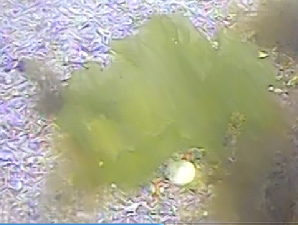
Figure 1: Ulva lactuca
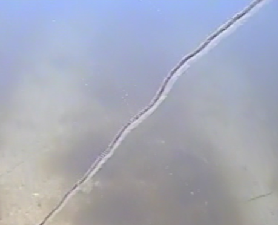
Figure 2: Chorda filum
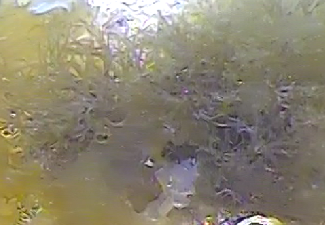
Figure 3: Chondrus crispus
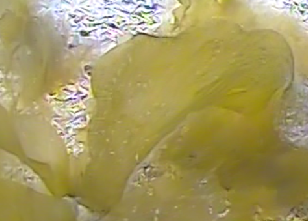
Figure 4: Petalonia fascia
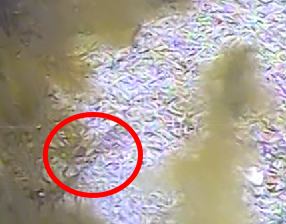
Figure 5: Goby spp. (Image quality poor but, once compared to photo image of Gobius couchi mentioned on the Joint Nature Conservation Committee website, was found to be identical).
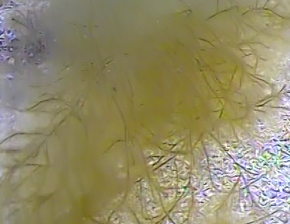
Figure 6: Unidentified algae/seaweed, confusion due to blurred images and cloudy surroundings. Possibly Chordaria flagelliformis (Although these are predominantly on rocky intertidal).
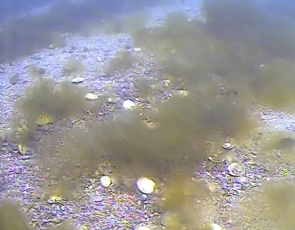
Figure 7: General seabed screenshot showing mass of shells, along with cloudy algal masses both of which were present along the entire of the seabed along station 1.
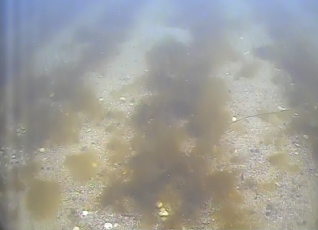
Figure 8: Initial screenshot showing calcareous seabed and vast presence of nebula-
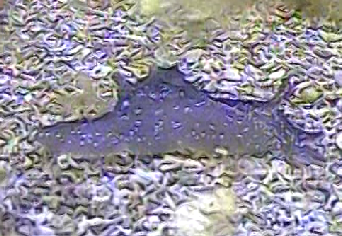
Figure 9: Aplysia punctate (Opisthobranch).
Findings at Camera drop Station #1:
Date: 25/06/2015 Time (UTC): 10:11:00am Lat: 5009.6’N Long: 0502.9’W
Findings at Camera drop station #2:
Date: 25/06/2015 Time (UTC): 10:28:00am Lat: 5009.6’N Long: 0503.1’W
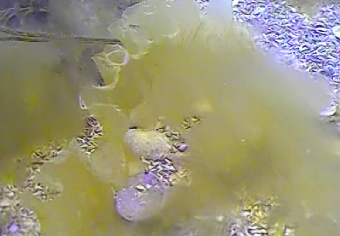
Figure 10: Laminaria saccharina
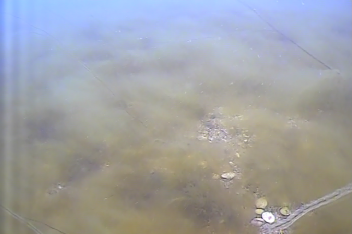
Figure 11: Vegetation at station 2 differed in that its distribution was in random patches which varied in size & density. As in station 1, seashells were seen present along the entire seabed.
Other species observed in station 2:
Chorda filum (much more dense presence).
Chondrus crispus.
Petalonia fascia.
Biodiversity and Species Information
Ulva lactuca
Commonly known as the ‘sea lettuce’, Ulva lactuca is a small green algal member of the chlorophyta reaching no greater than 30cm of length. Found ubiquitously at Northern latitudes at both exposed and sheltered shores, Ulva lactuca is a species which can tolerate most levels of the intertidal zone. The algae’s tolerance to brackish water allows it to exist in estuarine waters such as the Fal estuary (Pizzolla, 2008). This algae had a moderate presence in the first video drop footage, but was absent in the second.
Chorda filum
Chorda filum is a common UK species of brown macro algae, known by several common names such as dead man’s fingers or sea lace. The algae has earned such nicknames due to its long filamentous fronds which extend into the water column of the sheltered waters in which it favours as a habitat. This is a species only present in summer and it is known to completely disappear in winter. As C.filum was a highly abundant characteristic species in both video drop samples conducted in June, the area surveyed is likely to see seasonal changes in macro algae community structure. (White, 2006)
Chondrus crispus
A widely distributed rhodophyta, Chondrus crispus is found in the sublittoral zone of rocky shores around the British coasts. The algae is also known to occur in estuaries such as the Fal estuary where dense purple bushes are present. (Rayment, Pizzola, 2008) The presence of Chondrus crispus in the troughs of the bedforms gives some indication as to the lifespan of the ripples. Chondrus crispus is a species of a long life span, reaching up to 6 years in sheltered locations such as the survey area, suggesting the ripples are slow forming.
Petalonia fascia
Commonly known as the sea petal, Petalonia fascia forms olive coloured ribbon like fronds at great abundance in the Fal estuary, according to the area surveyed by video drops. This species prospers in shallow sheltered water such as harbours, and is similar to kelp in appearance but is much more delicate. (Seaweed.ie, 2015)
Laminaria saccharina
Laminaria saccharina is a fast growing brown kelp, growing in sheltered locations from winter until April annually. It is a very abundant component of the sheltered shore area sampled. It is known commonly as the sugar kelp due to the white sweet tasting powder that exists on its fronds. (White, Marshall, 2007)
Aplysia punctata
Aplysia punctata is a shallow water opisthobranch which can grow up to 20cm in length. Several adult individuals of this species were observed in the second video drop survey, but the opisthobranch was absent in the first. The colour of A. punctata is known to vary with the diet it maintains. Therefore, it can be presumed the A. punctata in the area surveyed of the Fal is feeding on the brown algae around it. (Sabatini, 2008)
Gobius couchi
Though gobies are a common character of the British coast, this particular species of goby has only been identified at 4 locations in England, one being Helford in South Cornwall, further down the estuary from the video drop survey. This species is a very rare and endangered species which takes shelter in the green and brown kelp present.(Riley, 2015)
Karen Riley 2005. Gobius couchi. Couch's goby. Marine Life Information Network: Biology
and Sensitivity Key Information Sub-
Joint Nature Conservation Committee. Habitat account -
Marisa Sabatini 2008. Aplysia punctata. A sea hare. Marine Life Information Network:
Biology and Sensitivity Key Information Sub-
Nicola White 2006. Chorda filum. Sea lace or Dead man's rope. Marine Life Information
Network: Biology and Sensitivity Key Information Sub-
Nicola White and Charlotte Marshall 2007. Saccharina latissima. Sugar kelp. Marine
Life Information Network: Biology and Sensitivity Key Information Sub-
Paolo Pizzolla 2008. Ulva lactuca. Sea lettuce. Marine Life Information Network:
Biology and Sensitivity Key Information Sub-
Seaweed.ie, (2015). Petalonia fascia (O.F. Müller) Greville. [online] Available at: http://www.seaweed.ie/descriptions/Petalonia_fascia.php [Accessed 26 Jun. 2015].
Will Rayment and Paolo Pizzola 2008. Chondrus crispus. Carrageen. Marine Life Information
Network: Biology and Sensitivity Key Information Sub-
The Falmouth Bay & Estuaries Initiative. (2000). Reasons for designation as a special area of conservation (SAC). Fal & Helford Special Area of Conservation Management Scheme. 1 (1), pg21.
The Falmouth Bay & Estuaries Initiative. (2000). Reasons for designation as a special area of conservation (SAC). Fal & Helford Special Area of Conservation Management Scheme. 1 (1), pg13.
Disclaimer: The views expressed here are not associated with those of the National Oceanography Centre Southampton or the University of Southampton.